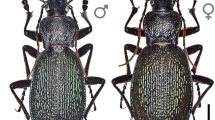Abstract
The defensive secretions of two tropical species of millipedes (the spirostreptid Telodeinopus aoutii and a species of Harpagophoridae) contain a complex mixture of closely related benzoquinones and hydroquinones. The major compounds are toluquinone and 2-methoxy-3-methylbenzoquinone, accompanied by the minor components, 2,3-dimethoxybenzoquinone and toluhydroquinone. Because of the large size and the geographic separation of the test animals a common defensive strategy of tropical, large millipedes against predation by vertebrates is assumed.
Similar content being viewed by others
Author information
Authors and Affiliations
Additional information
Received: 30 August 1999 / Accepted in revised form: 20 October 1999
Rights and permissions
About this article
Cite this article
Deml, R., Huth, A. Benzoquinones and Hydroquinones in Defensive Secretions of Tropical Millipedes. Naturwissenschaften 87, 80–82 (2000). https://doi.org/10.1007/s001140050014
Issue Date:
DOI: https://doi.org/10.1007/s001140050014




